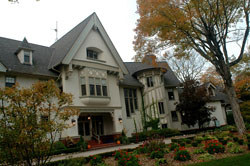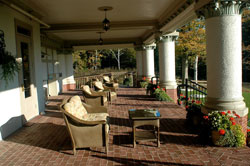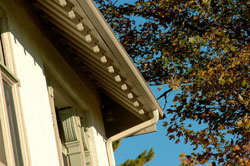 Most every autumn, my wife and I spend a few days in a beautiful old mansion hotel, and every year I come back rested, refreshed, puzzled and more than a little jealous. The problem isn’t that I wish I owned a place like this, but that I’m sorry to be reminded that so few people do, however wealthy they might be.
Most every autumn, my wife and I spend a few days in a beautiful old mansion hotel, and every year I come back rested, refreshed, puzzled and more than a little jealous. The problem isn’t that I wish I owned a place like this, but that I’m sorry to be reminded that so few people do, however wealthy they might be.
The mansion is called The Inn at Stonecliffe, and it’s tucked away in a quiet corner of a quiet island in Michigan called Mackinac (pronounced “Mackinaw”). The Inn at Stonecliffe was built in 1904 by Michael Cudahy, a meat-packing magnate from Ireland via Chicago, but he only enjoyed the place with his wife and seven children for five years before his death. But Cudahy’s mansion still lives on, beautifully maintained, and it’s one reason I’m stuck with a puzzling question: why is it that so many of today’s best homes fail to match the beauty of old places like the Stonecliffe?
Before I go on, let me make it clear that older is definitely not always better when it comes to houses. Quite the opposite. Many older homes fail to meet structural standards that are law today. The energy efficiency of older homes is universally dismal without upgrades, and most old houses impose huge maintenance burdens on their owners. But setting these things aside for a moment, there’s still no mistaking one other important fact. Without the aid of power tools, computer simulations, heavy equipment, cell phones, post secondary education and fossil fuels, builders of old often managed to create a level of beauty that’s almost never equaled in modern houses, regardless of the price tag. And it’s not that I haven’t been looking. For the last 25 years I’ve kept my eyes open, specifically searching for modern buildings that rival the best aesthetics of the late 1800s and early 1900s. Why am I not finding any?
 As near as I can tell, the best older homes have two main things going for them: thrilling and sophisticated design aesthetics, and a level of interior finish, intricacy and detail that we have an extremely difficult time rising to today, regardless of the building budget. The puzzling question for me is why so many new homes – even million dollar mansions – taste like cheap wine compared with places like the Stonecliffe?
As near as I can tell, the best older homes have two main things going for them: thrilling and sophisticated design aesthetics, and a level of interior finish, intricacy and detail that we have an extremely difficult time rising to today, regardless of the building budget. The puzzling question for me is why so many new homes – even million dollar mansions – taste like cheap wine compared with places like the Stonecliffe?
Part of the answer probably has to do with the level of craftsmanship developed by workers trained under the robust European apprenticeship cultures that builders of old came to North America from. As skilled as today’s best carpenters are, and as much as I respect them, I don’t know any of them who can custom-make the miles of one-of-a-kind trim and moulding required for a mansion using a set of hand planes, for instance. Where are the hordes of experts that must have been available to produce the acres of stunning stained glass, miles of ornate spiral staircases and 12-foot tall ceilings ringed with hand-carved crown moulding? Even if architects of today wanted to specify these things, it could only happen if we had plenty of insanely skilled people available in the labour pool to pull it off. We don’t. Power tools, ready-made trim and interior finishing systems, and a modular-based attitude towards building certainly lets us make decent looking buildings at lower cost and faster building schedules, but this seems to come at a steep aesthetic price.
 Finances also have something else to do with the current situation. If you study the pay rates of old-time trade workers, you’ll be surprised at how cheaply these geniuses worked. Day rates for a master carpenter 100 years ago were not much above minimum wage expressed in today’s dollars. The world was awash with highly trained, astonishingly skilled people when the Stonecliffe went up 107 years ago, and labour rates reflected this fact. And while I certainly wouldn’t want to work as hard and as well as builders of old did for as little money, there really is no substitute for thousands of highly skilled, energetic tradespeople eager to make miracles happen for little cash.
Finances also have something else to do with the current situation. If you study the pay rates of old-time trade workers, you’ll be surprised at how cheaply these geniuses worked. Day rates for a master carpenter 100 years ago were not much above minimum wage expressed in today’s dollars. The world was awash with highly trained, astonishingly skilled people when the Stonecliffe went up 107 years ago, and labour rates reflected this fact. And while I certainly wouldn’t want to work as hard and as well as builders of old did for as little money, there really is no substitute for thousands of highly skilled, energetic tradespeople eager to make miracles happen for little cash.
I hope all this doesn’t sound gloomy, because I actually find places like the Stonecliffe energizing. I hope you do, too. Just because we seem to have lost so much, it doesn’t mean that our current situation is the only way the world can be. Knowing what I do about tools, materials and building, I know that there are ways we can build better and more beautifully, even given current economics and the labour situation. The best place to start is by slowing down, looking around and learning what we can about exactly why the best old houses still make people feel so good. So far, the Inn at Stonecliffe is one of my favourite places to make this happen. Next year I’ll be going back with a tape measure, a journal and a renewed commitment not to feel too jealous.